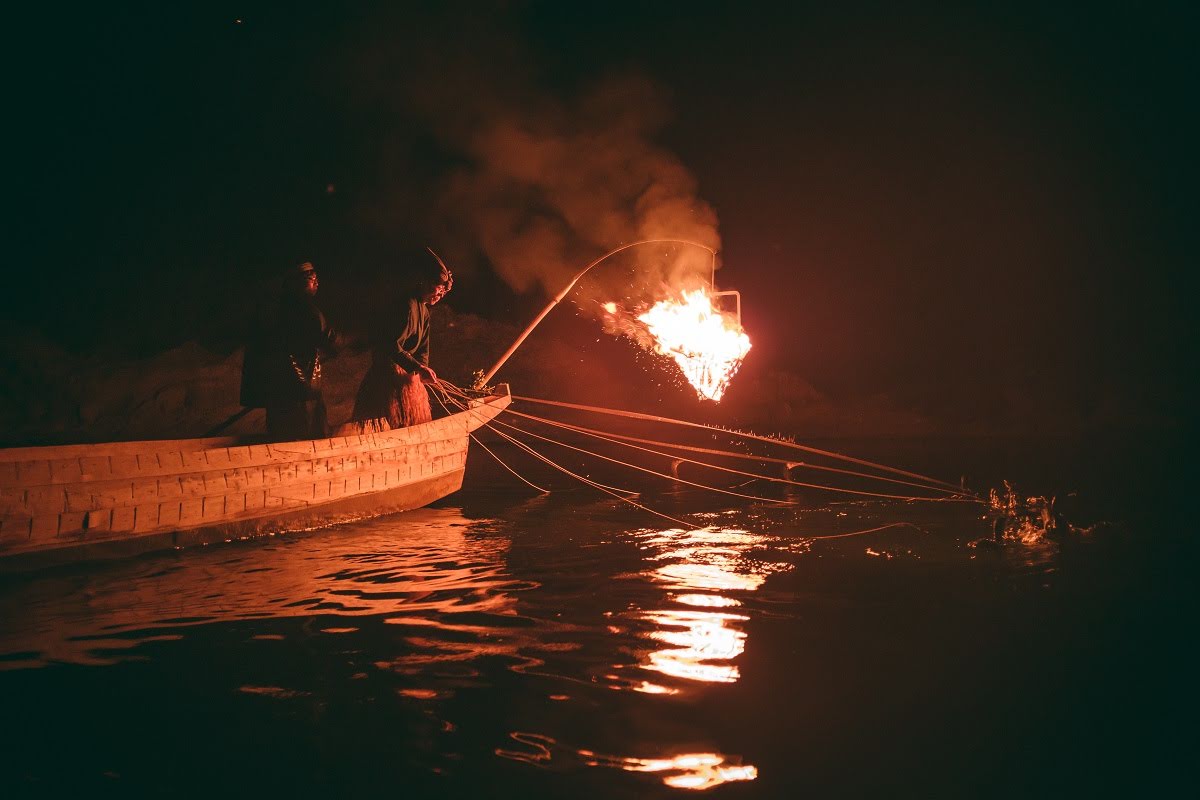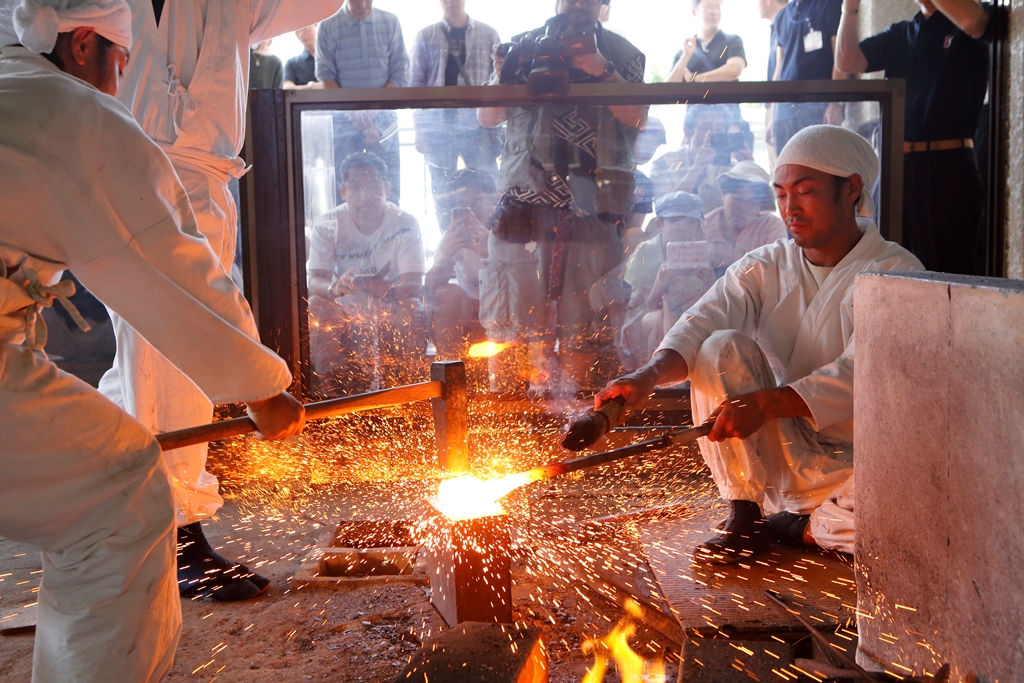An orange heart glows in the darkness, gently pulsing. A smoke tang hangs in the air, and the man wielding the molten steel comes into relief as he leans over the fire, his face smudged with soot. Sparks dance as he fans the flames, and he takes the red hot metal and places it on the anvil, raising his hammer high and bringing it down with a deafening clang . Sparks shoot out like laser beams around the room as he pounds, a rhythmic cacophony.
We are in the city of Seki, Gifu, also known as the City of Blades. Here, bladesmiths have been making swords, knives, and cutlery for 800 years. Located in central Gifu Prefecture, the town is cradled by two rivers. The clean water, good river clay used in the quenching process, abundant coal, and strategic location helped establish Seki as a steel forging powerhouse.

Today, Seki boasts a number of knife and cutlery makers. The Seki Cutlery Association has around 60 members and there are 10 traditional bladesmiths. Licensed by the government to keep the art of Japanese swordsmithing alive, they are the only craftsmen allowed to produce katanas. The hamono (cutlery) culture runs so strong in the town that it hosts an annual cutlery festival, the Seki Traditional Swordsmith Museum, the small Seki Hamono Museum, and countless knife factories and smiths, some of which are open to visitors. Seki is among the largest cutlery-producing areas in the world, along with Solingen in Germany and Sheffield, England.
We visited three knive makers in Seki to get a sense of this famous local product.
26 Generations of Sword Makers Crafting Seki Knives
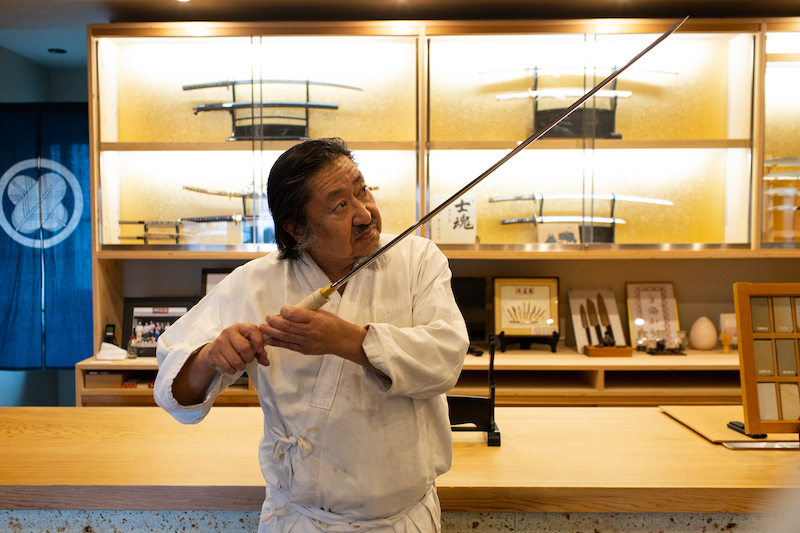
Swordsmiths have been crafting knives in Seki for 800 years, and the Fujiwara family has been creating swords for samurai and others for nearly the whole time. At Cutler Sanshu and the Seki Hamono Museum, we met Fujiwara Kanefusa XXV, a 25th-generation bladesmith, along with his son, Fujiwara Kanefusa XXVI, also a bladesmith.

Fujiwara XXVI guides us through the small museum, providing insights into the intricate process of crafting Seki knives. Japanese traditional knives are made from iron sand, sourced from Shimane Prefecture. The sand is combined with charcoal in a furnace burning at about 800ºC, in a process that takes three days with constant attention from several people. At the end of three days, a steel bloom remains, which is broken up and separated into five hardness levels. A high carbon steel called tamahagane, also known as jewel steel, is one of the most important hardness levels.
Once they create steel of different hardnesses from iron sand, the smiths go about combining the steels at 1300ºC. They hammer, lengthen, and fold at least 10 times. This process reduces the blade’s brittleness. “If you use only hard steel, it will cut well but break or chip easily,” explains Fujiwara XXVI. “But if you use soft steel, it won’t break, but it won’t cut as well.”
After molding and grinding the blade into shape, the smiths add a secret-recipe clay to the surface of the steel. “On the blade end the clay is thin, while on the back end the clay is thick,” says Fujiwara XXVI. “The application of the clay affects the wave patterns on the blade.” The continuous lengthening and folding of the steel makes a distinctive pattern, and smiths can usually tell from the pattern who made the sword.

The sword is then repeatedly heated to 800ºC and cooled by plunging it into water, which hardens the blade. The whole process from tamahagane to finished blade takes about 15 days. This process has been preserved across the centuries, and has changed little since the time when lords and samurai lived by their swords.
Today, sword making is regulated and only licensed bladesmiths may make katana, samurai-style curved single-edged swords. Today, ten such swordsmiths belong to Gifu. Each smith is allowed to make only two swords per month. Each sword must have a registration certificate, which proves that it was made by a licensed smith in the traditional manner.
Becoming a bladesmith is no easy task, and I wonder how they ensure quality. Fujiwara XXV invites us to witness a demonstration. We remove our modern parkas made of high tech fabrics, which could easily go up in flames with an errant spark. The Fujiwaras and their apprentices are wearing white cotton outfits, reminiscent of a karate gi. “Cotton doesn’t easily burn,” Fujiwara XXV tells me. Their white clothes are smudged with ash, but the white fabric represents the sacredness of their art, which is also reflected in the small Shinto shrine and decorations that hang above the forge.
Fujiwara XXV crouches over the fire contained by a stack of cinderblocks. Two apprentices bustle around, readying tools and scooping charcoal. Sparks fly as he works the bellows, a display of fireworks in orange and purple dancing over inky coal. A wooden basin of water stands ready.
The color shifts as the temperature rises. Fujiwara XXV pulls the glowing plug of iron out of the fire suddenly. The apprentices immediately start pounding in a practiced rhythm, both shouting with exertion. The clangs and screams ring out in a steady pattern, sparks flying. Beads of sweat drip down in the face of the heat. It’s incredibly intense, and I can’t help feeling that their power and fierceness are being imbued into the metal. As the sparks fly toward me, it feels like a little bit of that ferocity is being transferred my way.
Though the forming and shaping of steel takes about 15 days, the sword still needs a hilt, scabbard, and other mountings, which are usually made by other artisans. The finished piece can take anywhere from two to six months, or longer.
Becoming a swordsmith

I’m curious about the path to becoming a bladesmith. It isn’t easy, says Fujiwara XXV.
“It’s physically difficult.” But beyond that, it’s mentally demanding, and takes time.
To become a bladesmith, you must apprentice for five years under a licensed bladesmith, referred to as the master. “Training is strict,” says Fujiwara XXV. “When they first come, they split charcoal, clean the area and tools, make brooms, etc. “In time, they gradually learn more steps, mostly by watching the process. As they pound, I instruct them on points of hammering: How to wield the hammer, the color of the flames, the temperature, the meaning of the sounds coming from the steel.”
Taro Asano followed just that path. He doesn’t come from a smithing family; his interest was first piqued at 13, when he saw a master making a blade. At 20, he called Seki City Hall to find out the process of seeing a master in action, and took an initial weeklong study visit. Soon thereafter, he became an official apprentice with Fujiwara XXV.
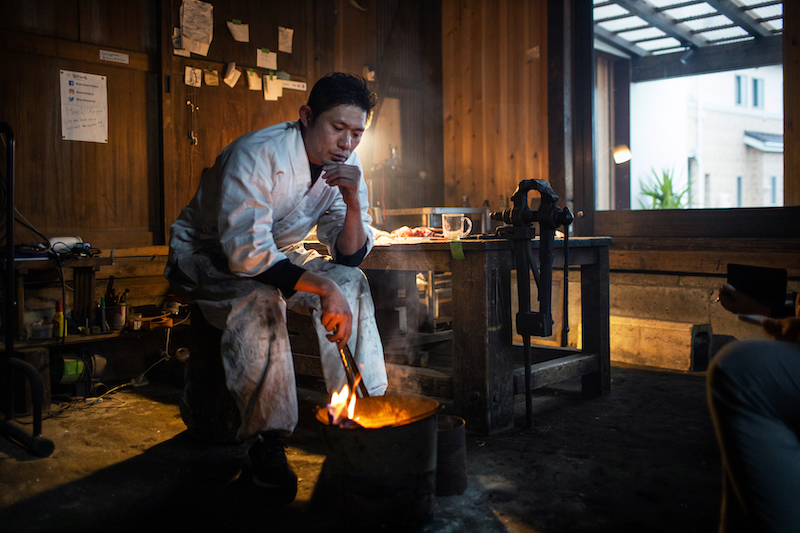
The first days were hard, and I can feel the frustration and tenacity coming off Asano as he describes those early times. “I started with cleaning and tending the coals. But everything was totally different once I started pounding iron.” A spark, you could say, had caught.
Apprenticing was tough, he says. “It’s a hard world to survive. Initially there was lots of self doubt,” says Asano. Apprentices don’t receive pay; In the past, apprentices might live with masters, but these days, it’s less common.
At the end of the five years, there’s a ten day exam. For those who do pass, the tradition is to return to their master and work for another year in gratitude. At that point, you can become an independent bladesmith. And after five years working independently, the bladesmith can be considered a master. Asano now has his own shop, called Asano Kajiya.
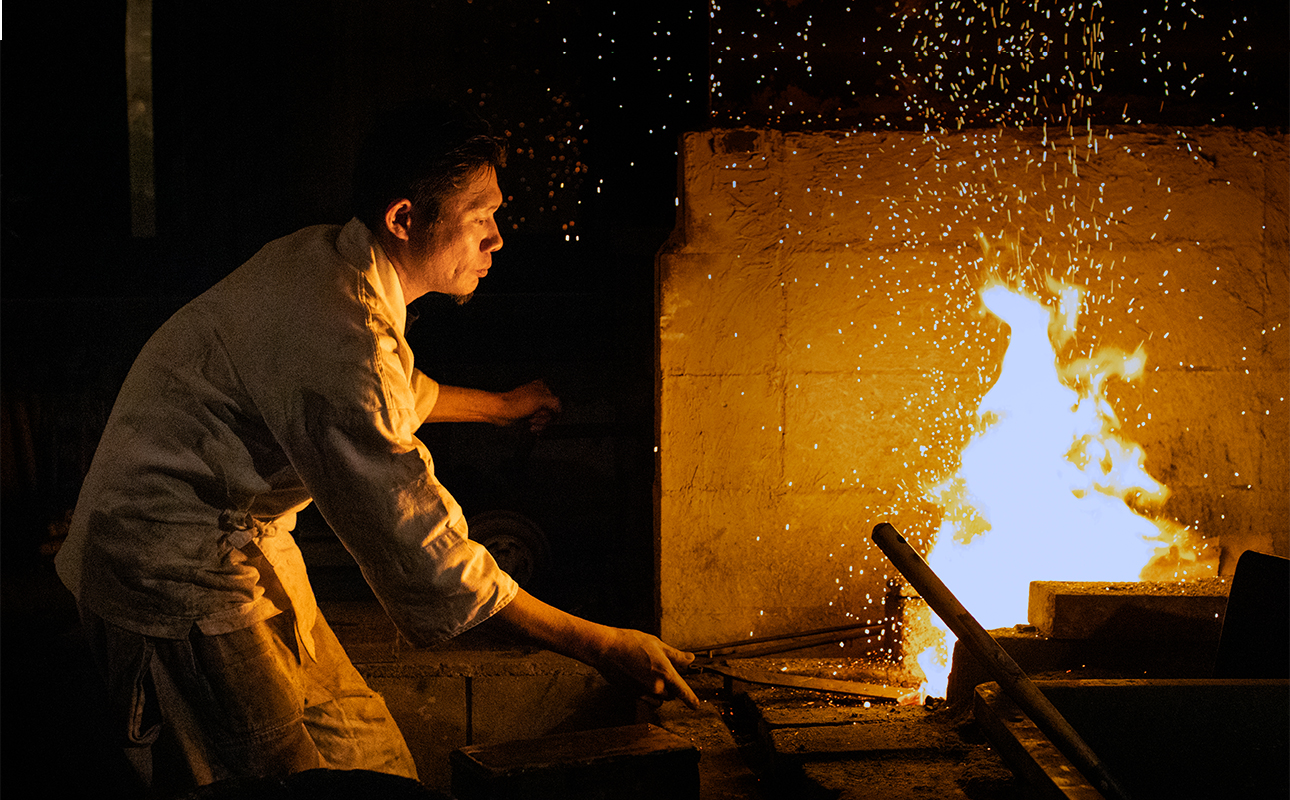
Cuts both ways
Swords aren’t the only cutting tools made in Seki. The city is well known for cutting implements of all kinds, from kitchen knives to toenail clippers.

One successful knife maker is G. Sakai. Yuhei Sakai, a frank and personable man in a work uniform, is a 4th generation knife maker, specializing in kitchen knives, folding/pocket knives, and outdoor knives that can be used for things like camping, fishing, sailing, and hunting. Especially popular is their line of rust-resistant knives, a must when working in the elements.
The company receives a number of OEM orders from manufacturers in the States such as Spyderco and Al Mar, and does about 50-50 in international and domestic orders. “We’ve build a reputation overseas for high tech, high quality, and high precision knives,” says Sakai. “We use strict quality control, and use special steel and materials that aren’t found overseas.” G. Sakai makes over 200 varieties of knives. “We even make knives for parachuting,” he says.
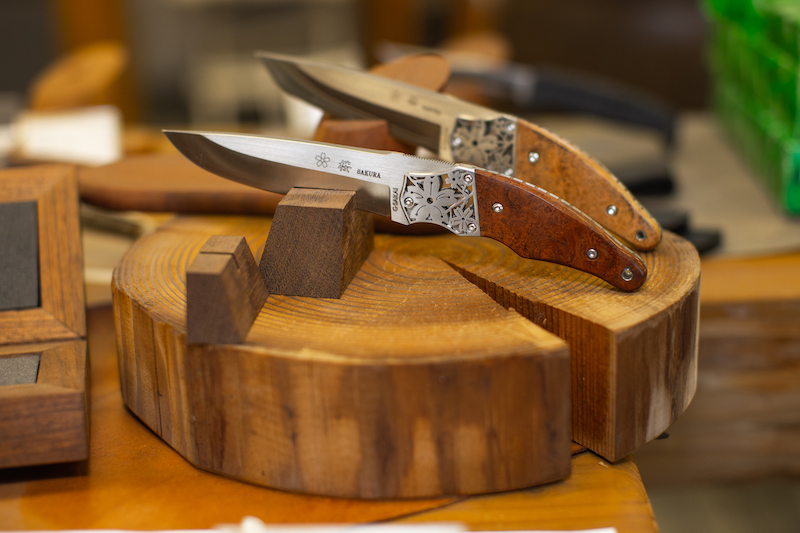
In Sakai’s grandfather’s day, knifemaking required a lot of manual labor. Of course, there was some machinery involved, but everything from punching to grinding required physical work and a high degree of craftsmanship.
These days, craftsmanship is still necessary, but machinery does a lot of the heavy lifting. That means that it’s hard to find workers who are familiar with the tech. G. Sakai works with laser cutting, stamping, and more automation, though 30% of the work is still handwork.

It’s clear that Sakai still enjoys the handwork. He offers tours of the premises, and there is a small knife museum on site. He also offers knife making experiences, and I gladly take him up on it. Under his tutelage, I build my own knife from Damascus steel. Not only do I choose the steel and the handle, but he guides me through several of the finishing and assembly steps, from polishing to sanding, to bringing out the steel’s pattern with iron chloride, and finally honing the blade and giving it an edge. When we finish, the knife is so sharp that it cuts through paper, and he bids me test it on a ripe tomato, where I take off translucent slices only a millimeter thick. I can’t wait to take home my prize and try it in my own kitchen.

The cutting edge
Sakai thinks that his business will only get more high tech, and offer more precision as time passes. He hopes that the new generation will be able to adjust to the tech so that they can continue to respond to the market, making excellent daily cutting tools.
By contrast, the laws governing bladesmithing mean that real katanas have to be made the old way. And bladesmiths realize that there isn’t much practical use for a samurai sword these days. Nowadays, “Katanas are made to commemorate big events, a birth, an emperor’s enthronement, a (sumo) yokozuna ascending,” says Fujiwara XXV. “Why make them? From the old days, this was a top art. Nobody else in the world does this. So the reason to make them is to continue the art, the tradition, to make sure it doesn’t disappear,” he says “Katanas are not just a thing that cuts. It’s a matter of the heart. It’s the heart of the samurai.”
So how can they bring this art into the future, I ask, using the old ways, in a way that the tradition can continue?
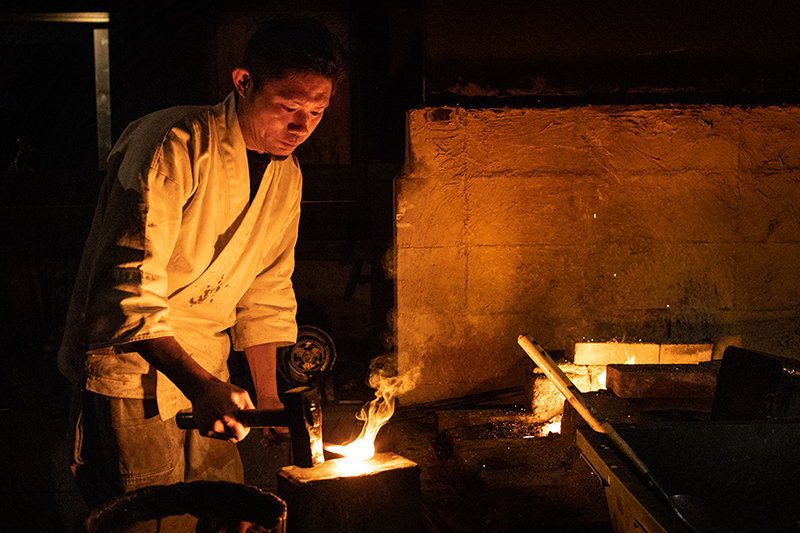
Asano believes that tradition shouldn’t be preserved for the sake of tradition, but that we should take the parts that work and apply them in the future. A part of his ideology that separates him from Seki’s traditional swordsmiths. He tries to spread the word about traditional Japanese bladesmithing by doing demonstrations all over the world. It’s paid off – he has a strong customer base both domestically and abroad.
Asano relates an anecdote. “I went to do a workshop at MIT. There’s a blacksmithing area, a forge there. Why?” he says. “They told me, MIT is very high tech, but high tech exists on a base of low tech. To let high tech survive and thrive, we have to protect low tech.”
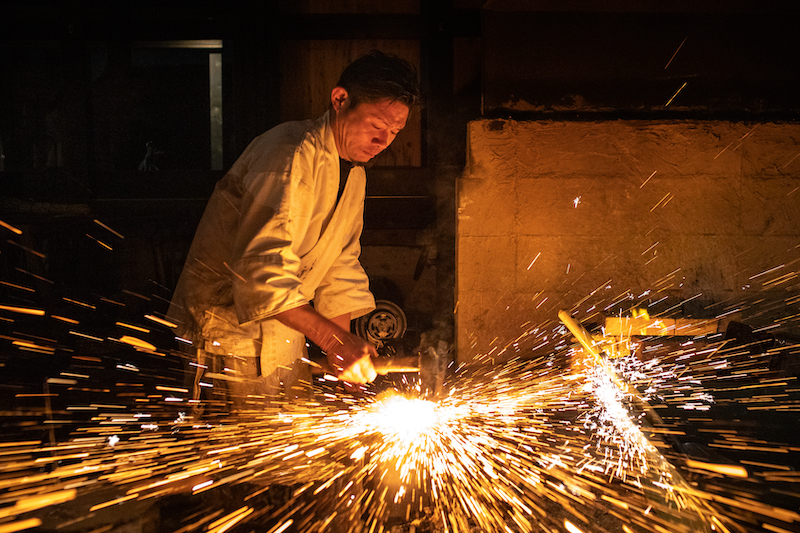
He says that many of the people who attend his workshop or visit his shop work in tech or finance, and that there is something in bladesmithing that appeals strongly even in the modern world. “They work hard but can’t touch their work, and everything is always changing. People want to make something from scratch that they can hold. Bladesmithing is the oldest art. It hasn’t changed.” He thinks there’s a demand for the old ways because in a digital age people want grounding, physicality. That’s one way that this art will survive.
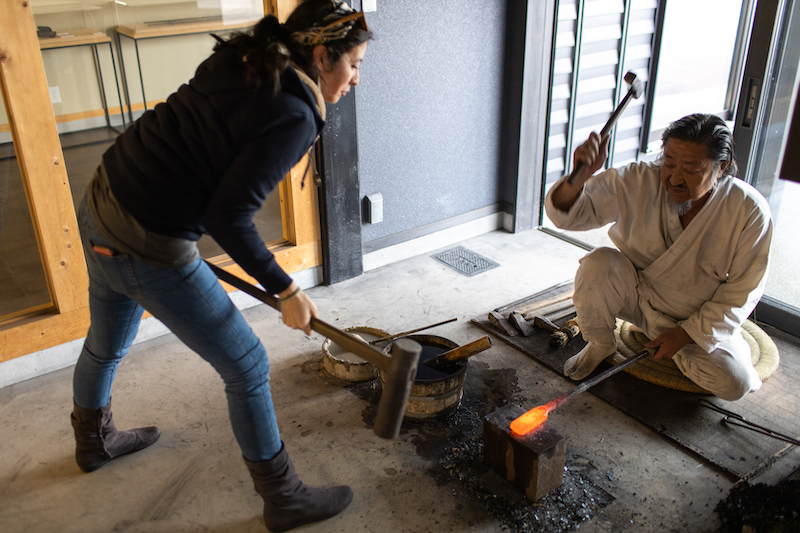
Fujiwara XXV hopes that the people of Seki will help to keep the tradition alive. “The people around here grew up with this tradition. We want them to have a feeling of pride, to want to share sword making with the world.” But even though swords are things of history and lore, he sees a place for them in the future, too, and with youth. He’s open to new ways of sharing swords with the world. “I would love to pass on the culture of katana through manga or anime,” he says.
My visit to the City of Blades taught me more than I had imagined. It gave me a new perspective and respect for these skilled swordsmiths and their legacy. I hope that others will share my interest and make a visit for their very own demonstration or workshop. Even if knives aren’t your thing, it’s easy to appreciate the craftsmanship and soul that goes into every blade.


















